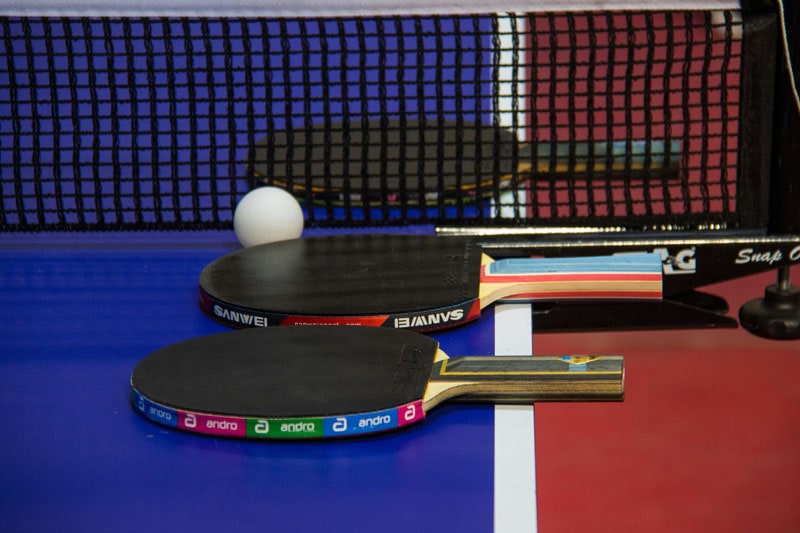Ping pong, or table tennis, is a fast, fun sport. People of all ages enjoy it worldwide. Ping pong began in the late 1800s as an indoor alternative to lawn tennis. It has since become a competitive sport with standardized rules and global tournaments. The game’s simplicity and accessibility make it popular. Its strategic depth attracts serious athletes. Understanding ping pong rules is essential for both beginners and competitive players.
Equipment and Table Specifications
Ping pong needs specific equipment and a standard table. This ensures fair play and consistency. Here’s a breakdown of what you’ll need:
Table
- Dimensions: A standard ping pong table is 9 ft (2.74 m) long, 5 ft (1.525 m) wide, and 2.5 ft (76 cm) high.
- Surface: he playing surface is typically made of wood and coated with a dark, non-reflective finish. It should bounce about 9 in (23 cm) when a standard ball is dropped from 11.8 in (30 cm).
- Lines: The table has a 2-centimeter-wide white line along each edge. It also has a center line for doubles play, running parallel to its length.
Net
- Height: The net stands 15.25 centimeters (6 inches) tall.
- Placement: It stretches across the width of the table, dividing it into two equal halves. The net should extend 15.25 centimeters (6 inches) beyond the table’s edges on both sides.
Ball
- Material: Ping pong balls are made of celluloid or similar plastic materials.
- Size: The ball has a diameter of 40 millimeters (1.57 inches).
- Weight: It weighs 2.7 grams.
- Color: Balls are typically white or orange and must be uniformly colored.
Racket (Paddle)
- Structure: The racket has a wooden blade and a handle. The blad has rubber on one or both sides for hitting the ball.
- Rubber: The rubber can be pimpled outwards or inwards. Players often choose their rubber based on their playing style.

Using the right equipment and knowing the table specs ensures the game meets international standards. It also provides the best playing experience.
Basic Ping Pong Rules
Understanding the basic ping pong rules is essential for playing the game. Here are the fundamental rules that govern the play:
Starting the Game
- Coin Toss: The game begins with a coin toss or a similar method to determine which player serves first.
- Objective: Players aim to strike the ball over the net onto the opponent’s side of the table.
- Bounce: The ball must bounce once on the player’s side before they return it. If the ball bounces more than once on a player’s side before it is returned, the opponent scores a point.
- Striking the Ball: Players can use either side of their racket to hit the ball. They cannot use any part of their bodies.
Scoring System
The scoring system in ping pong is designed to keep the game fast-paced and competitive. Here are the key elements of the scoring system:
Scoring Points:
A player scores a point when their opponent fails to make a correct service or return. Points are awarded when an opponent:
- Hits the ball out of bounds.
- Unable to Serve Properly.
- Fails to hit it after it has bounced once on their side.
- Commits a rule violation.
Winning a Game:
A game is won by the first player to reach 11 points, provided they have at least a two-point lead over their opponent. If the score reaches 10-10, play continues until one player has a two-point advantage.
Winning a Match:
Matches are typically played as the best of five or seven games. To win the match, a player must win the majority of the games. Players switch sides of the table after each game. In the deciding game of a match, players switch sides when the first player reaches 5 points.
This system keeps ping pong a dynamic, engaging sport. Players must be consistent and strategic to win.
Service Rules
The serve is a crucial part of ping pong, setting the stage for each rally. Proper service technique is key for fair play. It can also give a strategic edge. Here are the key rules regarding serving in ping pong:
Serving Technique
- Starting Position: The server must stand behind the end line of the table and between the sidelines.
- Ball Toss: The server must toss the ball up at least 6 in (16 cm) without spinning it. The ball must be visible to the opponent throughout the serve.
- Striking the Ball: The server must hit the ball behind the end line. It must first bounce on the server’s side before crossing the net and bouncing on the opponent’s side.
Legal Serve
- Net Clearance: The ball must clear the net and land in the opponent’s service court. If the ball touches the net on the serve but lands in the service box, a “let” is called. The serve is retaken.
- Service Box: In singles, the ball can land anywhere on the opponent’s side. In doubles, the serve must land in the diagonally opposite service box.
Service Rotation
- Service Change: Players alternate serves every two points. However, once the score reaches 10-10, serves alternate after each point until the game is won.
- Doubles Play: In doubles, service is made from a single side of the table. The serve must go diagonally from the server’s right side to the opponent’s right service box. The ball must first bounce on the server’s right side and then on the receiver’s right side.
Let Rule
- Definition: A “let” serve occurs when the ball hits the net but still lands correctly in the service box. In this case, the serve is replayed without penalty.
- Unlimited Lets: There is no limit on how many times a let can occur during a match. Each time a let happens, the server is allowed to replay the serve.
Understanding and mastering the service rules. As they are vital to maintain control of the game and capitalize on scoring opportunities.
Doubles Ping Pong Rules
- Court Division: In doubles, the table is divided into two halves by a center line, which is only relevant during service.
- Service Rules: The serve must go diagonally from the server’s right side to the opponent’s right service box. The ball must first bounce on the server’s right side and then on the receiver’s right side. Each serve is made from a single side of the table.
- Order of Play: After the service, players must alternate hitting the ball. For example, if player A serves to player C, the order would be A to C, then C to B, then B to D, and so on.
Rotation of Receiving Pair
- Service Rotation: Each pair of players alternates between serving and receiving every two points. For example, if team A serves, they will serve two points before team B serves. After team B’s two serves, team A will serve again, and so on.
- Post-Service Play: After the serve, players must follow the order of play, alternating hits. This means if player C receives the serve, player D must hit the ball next. Then, it’s player A, followed by player B. The sequence continues in this order.
General Doubles Rules
- Communication: Effective communication between partners is essential for success in doubles. Partners need to coordinate their movements and shot selections to avoid errors.
- Strategy: Doubles play requires strategic positioning and teamwork. Players often use different tactics, such as one player staying close to the table while the other covers the backcourt.
These detailed ping pong rules ensure fair, structured doubles play. They require teamwork and coordination from both pairs of players.
Common Violations
Ping pong rules ensure fair play, and violating these rules can result in penalties or loss of points. Here are some common violations in the game:
Service Faults
- Illegal Toss: The ball must be tossed vertically upward at least 16 centimeters (approximately 6 inches) without spin. If the toss is not legal, the serve is considered a fault.
- Hiding the Ball: The server must keep the ball visible to the opponent throughout the serve. If the server uses their body or clothing to conceal the ball, it’s a fault.
- Incorrect Serve: The serve must first bounce on the server’s side before crossing the net and bouncing on the receiver’s side. Failure to adhere to this rule results in a fault.
During Play
- Touching the Table: Players are not allowed to touch the table with their free hand or body during play. Doing so results in a point for the opponent.
- Ball in Play: The ball must be struck with the racket or paddle and not with any part of the body or clothing. If a player uses their body to hit the ball, it’s a violation.
- Double Bounce: The ball must only bounce once on a player’s side before being returned. If it bounces more than once, the opponent scores a point.
General Violations
- Out of Turn: In doubles, players must alternate hitting the ball. If a player hits out of turn, the opposing team is awarded a point.
- Net Interference: The ball must clear the net on the serve and during play. If a player touches the net or the ball hits the net and does not land in the correct area, it results in a point for the opponent.
- Failure to Serve: If a player fails to make a legal serve, such as hitting the ball outside the correct service area, it is considered a fault.
Knowing these common violations helps players avoid mistakes. It ensures the game follows the established ping pong rules.
Conclusion
Ping pong is a fast, fun sport. It needs skill, strategy, and precise technique. Understanding ping pong rules is essential for players of all levels to enjoy the game and compete fairly. The game’s details create unique challenges and excitement. They include the equipment, the table setup, and the scoring and service rules. The basic ping pong rules keep play fair and structured. The scoring and service rules add competition to each match. Players must know the differences between singles and doubles. They must also know common violations this helps players stay focused.







